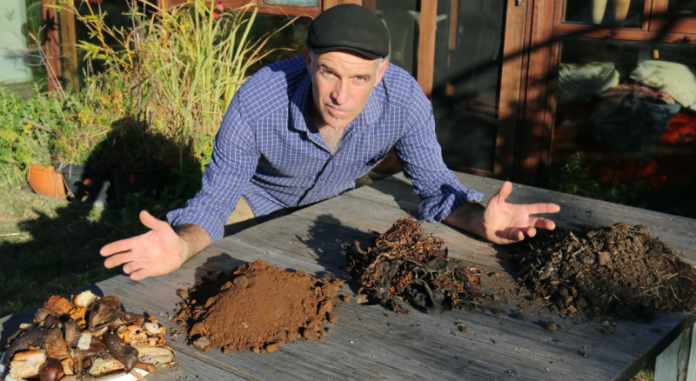
Many compost educators use the rule of ‘greens’ and ‘browns’ to differentiate between compost ingredients that are high in nitrogen (greens) and those that are high in carbon (browns).
Perhaps the idea originates from leaves and grass being ‘green’ (and high in nitrogen), while sticks and woody things are ‘brown’ (and high in carbon). If leaves, grass and sticks were the only things we made compost from, it might be a helpful way of sorting our ingredients. But composts are best made from a rich diversity of ingredients and many of them don’t fit the ‘greens’ and ‘browns’ rule.
A well-balanced compost at the start of its decomposition journey will have a carbon nitrogen ratio (C:N) of about 25 – 30 parts of carbon to each part of nitrogen. (See‘Carbon/Nitrogen’ article on the YIMBY website.)
Any ingredient with a C:N lower than 25:1 will be too nitrogen-rich to compost well on its own, and needs to be blended with more carbon-rich ingredients. Anything with a C:N higher than 30:1 will be too carbon-rich on its own and will need more nitrogen-rich ingredients to be balanced.
The ‘greens’ and ‘browns’ rule tries to sort every compost ingredient with a C:N above 30:1 into the ‘browns’ category, and everything with a C:N under 25:1 into the ‘greens’ camp.
So, how does the rule stack up in the real world?
Let’s consider manures? Are they ‘browns’ or ‘greens’? They are pretty brown in colour, yet manures are on the nitrogen-rich side of a balanced compost, so, according to the rule, are a ‘green’. Some manures, like chook poo, are the most nitrogen-rich ingredients we might add to a compost pile.
How about coffee grounds? Brown in colour, but actually on the nitrogen-rich side of the compost ledger, so theoretically a ‘green’.
Many seaweeds, like kelps, are brown (or yellow brown) but are definitely nitrogen-rich, and if used too liberally will make compost stinky and heavy, but are wonderful additions when lightly sprinkled through the compost layers. So, seaweed should be counted as a ‘green’ regardless of colour.
Food scraps are the nitrogen power house of many backyard composts and provide the big nutrient hit for YIMBY composts, yet food scraps come in a huge array of colours, of which green is just one.
The exceptions to the rule are so numerous that I have come to the conclusion that the ‘greens’ and ‘browns’ rule is more confusing than it is helpful.
At YIMBY workshops and in this column, we use the terms ‘nitrogen-rich’ and ‘carbon-rich’ to describe ingredients that are on either side of an ideal balanced carbon-nitrogen ratio. It still requires us to do some thinking and perhaps a little home-work, but I think it leads to less confusion, and I suspect, better compost.
– Joel Meadows works with *Yes In My Back Yard, (YIMBY), a community-scale composting initiative in Castlemaine and surrounds. Send questions or comments to hello@yimbycompost.com, or to book in for a compost workshop.






